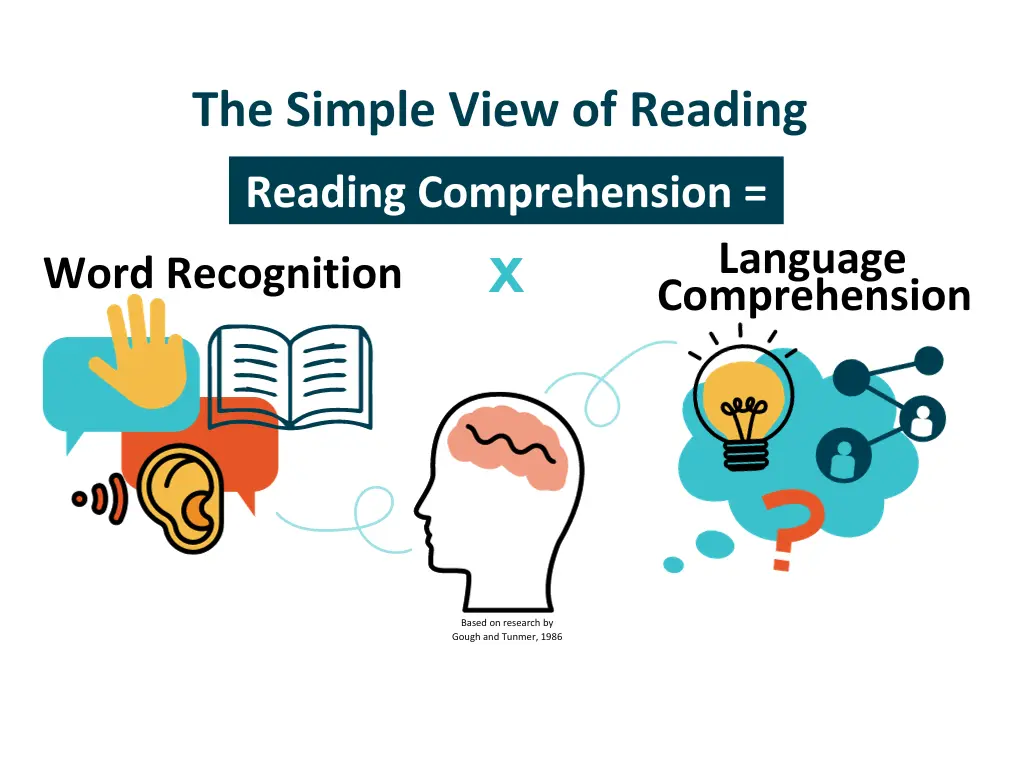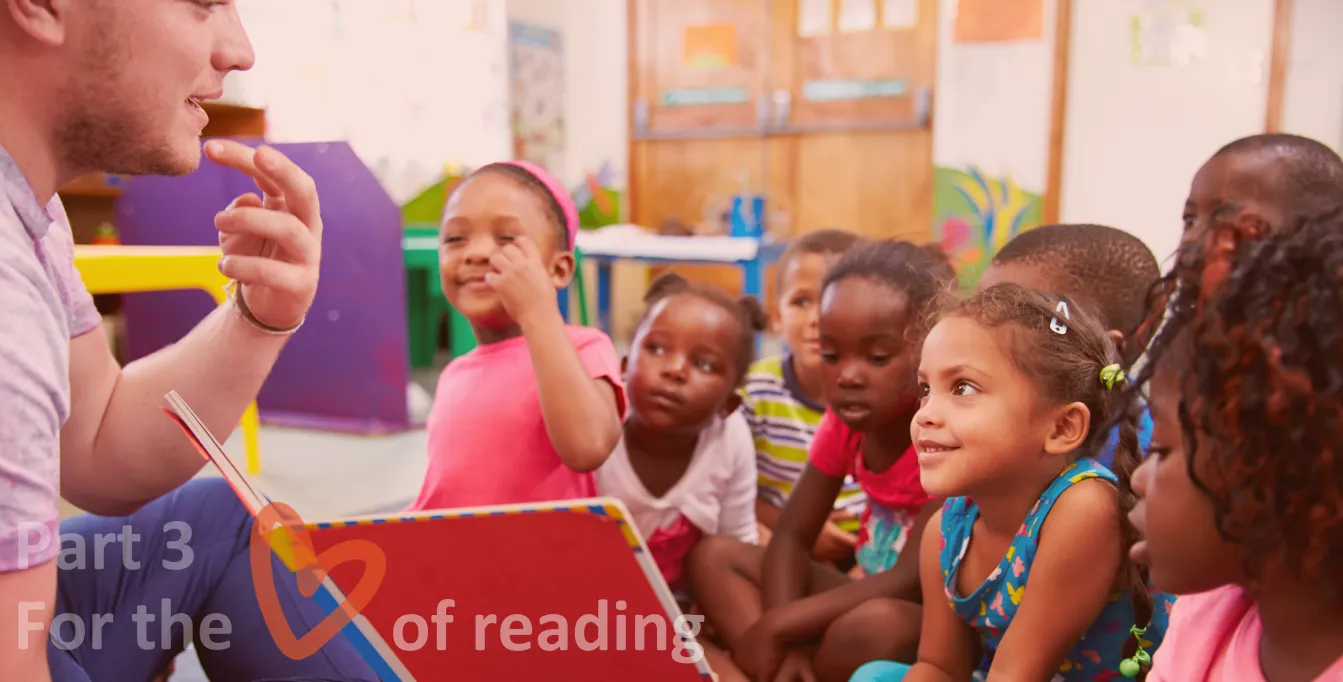Educators, parents and caregivers, literacy experts, and school leaders: This series is for you! Kids Read Now is thrilled to present this series on how students develop strong literacy skills from guest author Dr. Wendy Strickler, Assistant Professor in Reading Science and Director of Teacher Advancement Programs at Mount St. Joseph University in Cincinnati, Ohio.
Cracking the phonics code unlocks the power of Word Recognition
In the first blog post, I described the formula for thinking about parts of reading called the Simple View of Reading. To build proficient reading skills, we need to help kids develop printed Word Recognition and Language Comprehension.
Early on, these skills are developed separately because kids are working on “reading” (cracking the code) for smaller words than they are ready for in learning word meaning.
This blog will focus on one early skill that is part of Word Recognition: phonics (recognizing the symbols that represent sounds of language and blending those sounds together to read words).

Word Recognition: Part Two
Games: Looking at letters and practicing knowing what the sounds are that go with those letters…
Earlier literacy skills:
- Look for letters everywhere in our environment. Help your kids to notice letters and point out ones they know. Although letter names are important, letter sounds are actually more important to being able to read (I need to sound out the word), so when you notice letters, talk about the name AND the sound it makes.
Advanced literacy skills:
- Practice blending known letter sounds together to figure out basic words. Use fridge letter magnets, foam bathtub letters, or any other fun letters to put 3 letters together with a vowel in the middle and sound out new words together. Make sure to use letters and sounds your child knows, so they can figure it out and this is fun!
- Early on, have kids read books with the sounds they know and not sounds they haven’t learned yet. If you are reading together, read to them and only ask them to read words they should be able to figure out because you know they know the sounds and understand how to start blending them. We don’t want kids guessing at words. We want to teach them the sounds so they can figure out the words.
- As students become better readers, they can start reading more and more text because they have the skills to tackle all the words.
There are a growing number of decodable or “controlled” text that build on logical progressions of phonics skills. Providing students with lots of practice with their newly acquired phonics skills is critical to building their accuracy and automaticity with text. Ask your librarian to see these resources, and find additional lists of these texts from The Reading League and Reading Rockets!
Dr. Wendy Strickler has a Ph.D. and Masters from the University of Cincinnati, with a Curriculum Instruction and Professional Development license from Miami University. She has taught courses at Mount St. Joseph University in Cincinnati, Ohio and worked in PreK-12 education for about 20 years. She is currently serving as an Assistant Professor in Reading Science & Director of Teacher Advancement Programs. Her career began with teaching preschool for children with developmental disabilities in Montreal, Canada. More about Dr. Wendy Strickler
Grow your toolbox of ways to develop strong literacy skills
From the previous blog posts, you read about some new phonological awareness games, how to speak whale, and activities you can do in the dark that develop strong literacy skills, specifically verbal and auditory language skills.
Like your young students, you’ve got the necessary prerequisites for moving on to more complex aspects of literacy acquisition.
But wait… Isn’t it the Simple View of Reading?
As you well know, the cognitive processes involved in learning to read are incredibly complex. Further, the conceptual knowledge base and instructional skills challenge even the most experienced professionals.
It’s easy to forget the big picture of why you do what you do for kids… It’s for the LOVE of reading.
What’s up next?
Remember our formula for successful reading? It’s a multiplication equation: WR x LC = RC
In blogs 2 and 3, we got to the bottom of the first factor, Word Recognition (WR). You read about phonological awareness activities that sharpen auditory and verbal skills (think Dory and her whale noises…), as well as how children’s brains “lift words off a page” at varied levels of literacy.
Still, if Reading Comprehension (RC) is the product of two factors, it doesn’t matter how skilled a student is at Word Recognition (WR) if the other factor is not also strong and skillful.
Think back to elementary math: any number times zero equals zero. This doesn’t fare well for good decoders with poor Language Comprehension (LC).
In the final blog by guest author Dr. Wendy Strickler, you’ll zoom in on Language Comprehension, what exactly it entails, and ways to help students develop strong literacy skills and strengthen this necessary foundational piece. In other words, true to the title of this series, you’ll get ideas to help develop strong literacy skills.
And don’t forget: It’s all about the love of reading.
Frequently Asked Questions
Letter sounds are more critical than letter names when learning to read because they directly relate to phonemic awareness and phonics—the foundational skills for reading. Knowing letter sounds allows students to decode words by sounding them out, a crucial skill for early reading. Letter names are valuable but secondary in the process of learning to read.
Educators and caregivers can use tools like alphabet charts, flashcards, phonics-based apps, and hands-on activities such as letter sound games, magnet letters, foam letters in the bathtub, and puzzles. These tools provide visual and interactive ways for students to practice and reinforce letter sounds, making learning engaging and concrete.
Phonics is a method of teaching reading that focuses on the relationship between letters (graphemes) and the sounds (phonemes) they represent in words. It involves teaching students how to decode words by recognizing these letter-sound correspondences.
Phonics is a crucial component of the Science of Reading, an evidence-based approach to teaching reading. The Science of Reading emphasizes systematic phonics instruction as one of the foundational elements for developing proficient readers. It draws on research from cognitive science and linguistics to provide effective strategies for teaching reading, with phonics playing a central role in building reading skills.
Reading aloud offers numerous benefits, including building vocabulary, enhancing comprehension, and fostering a lifelong love of reading. It also provides valuable bonding time and models fluent reading, which helps children become better readers themselves.

